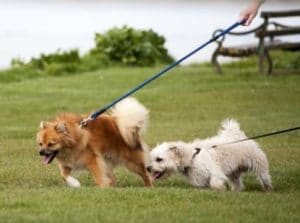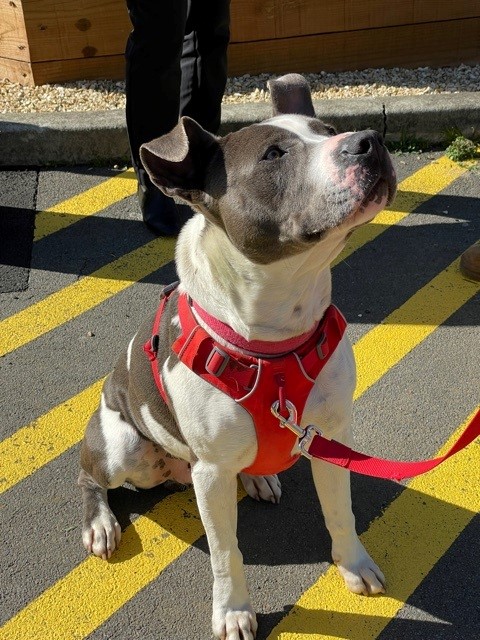Like to stay updated on what is happening at the Dogs' Homes?
Enter your details below to join our monthly mailing list for the latest news, events, rescue stories plus helpful tips and ideas for dog lovers.
Historically collars have always been used on dogs. We can attach name tags; registration tags and leads to them.
These days we know that there is little physical difference between human and dog necks. Collars can cause damage to a dog’s neck causing pain which can negatively impact on behaviour. In the best interest of our dogs, the Dogs’ Homes of Tasmania has decided to use harnesses when walking dogs.
Research shows that the pressure from jerking and long-term pulling when using a collar and lead combination, can cause damage to soft tissue in the neck including the thyroid gland, oesophagus, trachea, jugular veins, and spinal column.
Dogs with eye issues are at risk of more damage from the restriction of blood and lymphatic flow to and from the head.

Pulling on the lead can also cause coughing and breathing distress, particularly in brachiocephalic breeds (Pugs, boxers etc.). The higher a collar sits on the neck, the greater the risk of damage. (1)
Of particular concern are check collars and prong collars which can cause major damage. As one article suggests:
It would also appear to be desirable to inform dog owners of the risks that may be associated with the over-enthusiastic use of choke chains and similar means of restraint.
Gardner, D.E et al, Calcinosis circumscripta-like lesions in dogs associated with the use of choke chains., New Zealand Veterinary Journal,23:5, 1975, p.97

Head halters are also problematic with the risk of neck and back injuries. They should never be used with retractable leads.
Some dogs find head halters unpleasant, and a few will shut down while wearing the halters. Unfortunately, dogs that shut down will appear calm or quiet. Again, dogs wearing halters should never be ‘corrected’ with jerking.

Vets already recommend harnesses for dogs with neck injuries. Using the right harness will take pressure off the neck.
The most comfortable harness is the Y front harness also known as the H harness, as it doesn’t inhibit movement through the shoulders and front legs. The front rests on the sternum rather than on soft tissue. (2)
A well fitted harness is more secure than a collar that a dog can slip out of, particularly if the dog is spooked. Some harnesses have a handle which can be useful to hold onto near traffic or in an emergency.
You will want to ensure that it fits snugly but not tightly and that it doesn’t rub just behind the front legs (armpit). Ensure that the clips don’t dig in or rub.
Harnesses will have a clip attachment for your lead at the front – good for dogs that pull and/or a clip attachment on the back. For strong dogs there are leads that you use to attach to both clips.
The back clip of a harness can also be used in cars to secure your dog with a seat belt attachment. Should you stop in a hurry a harness will spread the load while a collar attached to the seatbelt will cause severe injury to the dog’s neck.

There is a legal (3) limit on the length of lead that you can use on footpaths in general public areas of 2m. This is a good length for general walking. Please do not use retractable leads. The risk of injury and accident to dogs and other people is such that we do not recommend them. If you are walking in bush areas, consider getting a longer lead of 3m to 5m.
The best way to avoid pulling, is training.
References.
1.Gardner, D.E et al, Calcinosis circumscripta-like lesions in dogs associated with the use of choke chains., New Zealand Veterinary Journal,23:5, 1975, p.97
2. Smiling Leash, Muscles and why the harness type matters. Accessed 13.9.21 https://www.smilingleash.com/blog/muscles-and-why-the-harness-type-matters
3. Dog Control Act 2000, Tasmanian Government. Section 4(1)(a)
Enter your details below to join our monthly mailing list for the latest news, events, rescue stories plus helpful tips and ideas for dog lovers.
Dogs’ Homes of Tasmania (DHOT) has been here for dogs for over 70 years. We re-unite lost dogs with their families and find new homes for unwanted dogs. We are committed to zero euthanasia of healthy, temperamentally sound dogs.


© 2022 Dogs’ Homes of Tasmania.